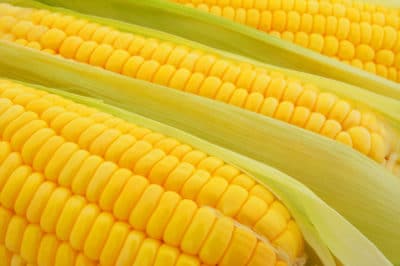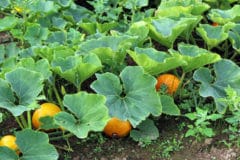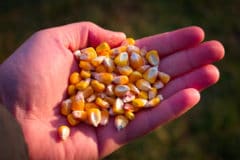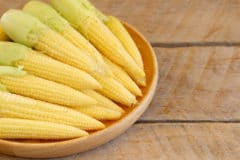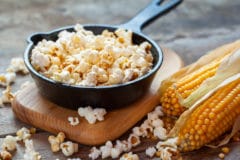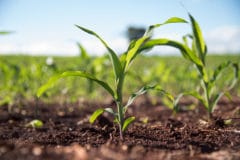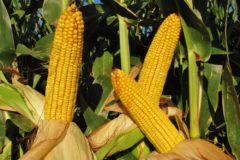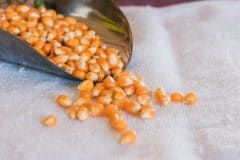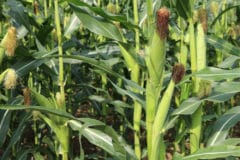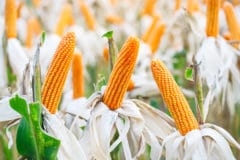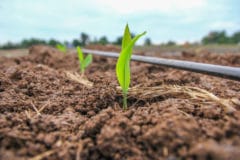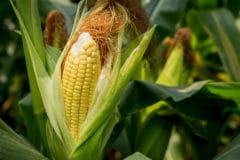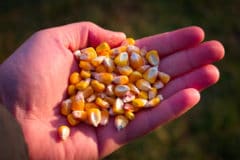Where Does Corn Grow?
Corn is a versatile vegetable, and you can grow it nearly anywhere. Even if you live in an area with a short growing season, you can buy a variety of corn that matures quickly. “Early Sunglow” and “Quickie” are just two of the many types of early-maturing corn seeds.
While most of the corn used in production is grown in the Midwest in states like Kansas, Nebraska, and Iowa, gardeners everywhere grow it easily in their garden plot.
What Kind of Corn to Plant
The variety of corn you choose to plant is largely a personal preference. Many people prefer an early-ripening sweet corn variety to have fresh corn on the cob in the height of summer, but there are also sweet varieties whose harvest comes in late summer. Some of the more popular types of sweet corn include:
- Peaches and Cream
- Butter and Sugar
- Quickie
- Trinity
- Serendipity
Tip: Not all of the sweet corn varieties are ready for harvest at the same time. Be sure to read your seed packet to be sure when the seeds will mature.
Field Corn
Field corn is a very different type of corn than sweet corn. Although you can eat field corn, it does not have the same flavor as most sweet corn varieties. If you see a sign for “Roasting Ears” in a store or at a Farmer’s Market, you can almost guarantee it is field corn.
Most of the time, field corn is used for animal feed or grown to be ground into cornmeal or masa. Although it certainly will not hurt you to eat it, just do not expect it to be as sweet and flavorful as you are accustomed to.
Popcorn
An especially fun type of corn to grow, especially if you have children, is popcorn. Although the planting process is the same as for all other kinds of corn, you cannot use just any corn kernel as popcorn. Instead, you have to buy corn specifically labeled as popcorn.
Additionally, you do not harvest popcorn ears as they ripen. Instead, you leave them on the stalk to dry completely. You can also harvest popcorn ears and leave them to dry in a well-ventilated area, but they will not pop into those puffy morsels you crave unless you allow them to dry completely.
When to Plant Corn
Regardless of which variety of corn you grow, the time frame in which you need to plant is the same. Corn seeds are not cold-tolerant, so you need to be sure the soil has warmed to a minimum of 55°F (13°C). In most cases, your garden soil warms up about two weeks after the final frost date for your growing zone.
If you are unsure what your growing zone is, you can find that information through the USDA website, at your local nursery, or just asking a seasoned gardener.
Tip: If you are a novice gardener, you should use a soil thermometer to measure the warmth of your garden plot rather than just guessing. You can purchase one at any home and garden store.
Where to Plant Corn
The best place to plant corn is in an area that gets full sunlight (a minimum of six hours a day of direct sun). The ground should be free of rocks, and you should also be sure there is adequate drainage. Since corn plants have a reasonably long taproot, you should not plant your seeds in heavy soil.
Each corn stalk only produces 2-3 ears of corn, and super-sweet varieties often provide only one ear. Therefore, you need to plant corn in a relatively large area.
Tip: When planning your garden, remember that corn plants are tall and will shade the plants around them. Do not plant anything that requires full sun directly next to your corn.
How to Plant Corn
Before you can even plant your corn, you need to be sure the soil is ready. During the two weeks after the last frost, while you are waiting for the ground to warm, you can prepare your plot. If your soil is heavy, you can amend it with sand and organic compost to create a loose soil bed for your corn seeds. Additionally, working an excellent organic fertilizer into the soil will give your corn seeds the best start possible.
When it is time to plant, mark your rows, making sure they are at least eight inches (20 cm) apart from each other. Unless you are growing on a large scale, you should plant the corn in short blocks rather than long rows. Doing so makes pollination more natural, which is integral to producing ears.
Plant corn seeds at one inch (2.5 cm) depth and four inches (10 cm) apart. Once the seeds germinate and have grown two sets of leaves, pull the weakest plants. You should have one sturdy plant every eight inches (20 cm) when you have thinned the plants.
Tip: Planting corn is the same process regardless of what variety of corn you are growing.
Caring for Corn
As you know, preparing the ground for planting and getting the seeds into the ground is only the beginning of the process. Corn is no different in that respect than any other garden plant. In addition to the correct type of soil and adequate sunshine, you also need to provide other elements for your young corn seedlings.
Fertilizing Corn
Corn is considered a heavy feeder, which means you need to be sure to apply regular applications of an organic fertilizer that is rich in nitrogen. The first application should be right before you plant the corn seeds. Fertilizing before planting provides nutrient-rich soil to give your corn seeds the best start possible.
You should also plan on applying a nitrogen-only fertilizer when the stalks are about six inches (15 cm) tall, and then a final application of the same fertilizer when the ears start producing silk.
Tip: You can find high-quality organic compost and fertilizer at your local nursery or home and garden store.
Watering Requirements for Corn
Although corn tends to thrive in hot places, it is not a drought-tolerant plant at all. For the corn kernels to fill out and become juicy, you need to water your corn regularly. Plan on watering your corn at least weekly, saturating the roots. If you live in an area where you have long, hot, dry spells, you will need to water more frequently.
Tip: Sprinklers that water from above are not very effective for watering corn. Instead, use a soaker hose or a sprinkler that is low to the ground to allow the most water to reach the roots.
How to Make Corn Happy
In addition to applying fertilizer and watering your corn frequently, there are a few other necessities for making sure your corn plants are happy, healthy and thriving.
Control Weeds
Since corn plants have a shallow root system and only one long taproot, it is essential that you keep weeds under control. Otherwise, the weeds will crowd out the roots and steal vital water and nutrition from the corn. The easiest way to control weeds is to apply a thick layer of organic mulch around the base of the corn stalks. Then, you can more easily eradicate the remaining weeds by hand or by using a hoe.
Watch for Disease and Pests
Several diseases are common to corn, such as southern corn leaf blight and common rust. The sooner you notice an anomaly in your corn crop, take immediate steps to identify and treat the problem. Otherwise, you can easily lose your entire crop to a preventable disease.
The same holds true for pests like the corn worm or the European corn borer. Pay close attention to your corn plants and treat the pests as soon as possible. Most pests can ruin your entire harvest if you do not treat them as soon as you find them.
Harvesting Corn
You will know that your corn is ready to harvest when the ears have filled out, and the corn silk has started to dry. To tell if your corn kernels have filled, lightly squeeze the ear of corn from top to bottom. Although it is common to have some unfilled kernels at the top of the cob, it should be firm and resist slightly when you squeeze.
If the variety of corn you planted is one of the super-sweet varieties, you should pick the corn immediately before eating it. The sweetness starts to decrease the longer between picking and cooking, so for optimum taste, you should pick and husk it minutes before plopping into the pot or throwing on the grill.
Since eating fresh buttered sweet corn is the best part of the entire corn growing season, you can extend that bliss by planting seeds at two-week intervals for the first six weeks of the season. By staggering your planting, you can easily be eating sweet corn all summer long!
